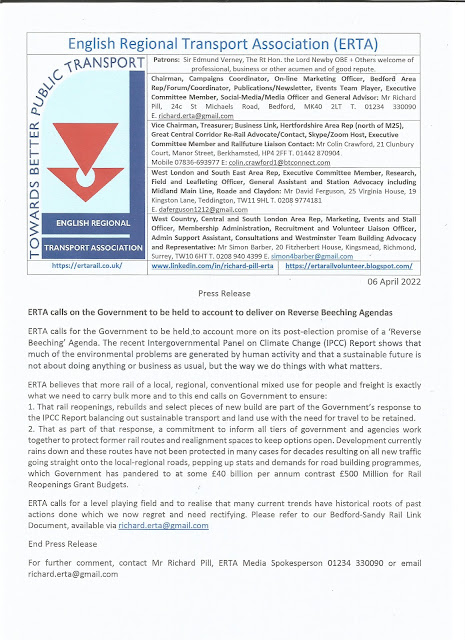ERTA Ampthill and
Flitwick Forum:
Saturday 10th
September 2022, 1pm food* 2-4pm business.
Venue is The Swan
Pub, 1 Dunstable Road, Bedford MK45 1HP
It is adjacent to the Thameslink-served railway station and with ample parking and bus links too. https://www.swaninnflitwick.co.uk/menus/
Write
in support of a new additional station for Ampthill to:
1. Ampthill Town
Council: https://www.ampthilltowncouncil.org.uk/contact
2. Central Beds Council:
https://www.centralbedfordshire.gov.uk/directory/14/a_to_z/B
3. MP for Mid Beds: Ms
Nadine Dorries https://members.parliament.uk/member/1481/contact
All
welcome. If coming please email richard.erta@gmail.com
Any offers with
reliable leafleting around Ampthill and Flitwick ahead of this event are
welcome. Please let us know. All offers to help, assist and lead are also
welcome to entertain please. Make it your campaign and endeavour too! It is all
voluntary.
*Everyone is responsible to buy and pay for their own food and transport costs.
Apologies
were received from a Mr Steve Anderson of Centre Parcs and Nadine Dorries MP
for Mid Bedfordshire Constituency which includes Flitwick and Ampthill.
We followed an agenda and there were many questions and discussions. Some ranged from the inadequacy of Flitwick Station in a context of growth and demand for more parking over coming years. Others that Ampthill would be both a relief station and compliment Flitwick as well.
Bus integration, cycle-pedestrian access, lowering speed and installing either a footbridge or crossing at the junction of Station Road Ampthill and A507 and the station access road which currently serves as an industrial complex. Some relocation packages would need brokering as per protection of lands west side of the Midland Main Line, which we understand is under threat of development in coming years.
It was admitted the population in a 5-mile catchment has and is expanding and Flitwick Station alone cannot cope beit lack of land for expanded parking, the road layout and single bridge over the railway and congestion and parking in local streets all would be partly resolved with the addition of An Ampthill railway station.
Action Stations:
It was explained that ERTA is a stretched voluntary outlet which is in the business of planting ideas. It needs public, elected representatives, all tiers of governance to support those ideas and in turn commission/access funding pots to work up the case and formal credentials with a view to courting Government support and ultimately a permission towards delivery. Landowners, leisure outlets, councils of all tiers, agencies and many more could contribute to a pot with studies in mind to find answers to questions, see what needs to be done and through policy and action, set about moving the agenda towards delivery.
Summary of key points:
1.
It needs funding for a study
2.
land retention to keep western approaches and other access routes viable
3.
Relocation packages
4.
May only be a half hourly frequency of Thameslink’s, but given plethora of
frequency, it should be perfectly possible to absorb into a timetable.
5.
Buses and inter-rail/bus-train ticketing could retain viability of bus networks
more.
6.
A need to get tiers of governance on board and in particular the Central
Bedfordshire Unitary Council to help and work with us and be instrumental in
gathering people, resources and round-tabling in a view of a good idea, not
dismissing it.
7. The growth means something needs to be done or retained as a viable option.
Next
meeting: same venue The Swan Pub, 1 Dunstable Road, Bedford MK45 1HP
T: 01525 754777 E: steph@theswanflitwick.co.uk It is adjacent to the Thameslink served railway station and with ample parking and bus links too. https://www.swaninnflitwick.co.uk/menus/ and will be 1pm food, 2-4pm business on Saturday 10th September – all welcome to come, meet and join as members and offer to assist or lead accordingly please.
Meeting
closed 15.10pm and it was felt as a first post-pandemic, it was a useful
exercise and potential still to build on towards getting local people to help
more and give the vital support, holding elected representatives to account and
take an interest.






.png)
.png)







